
95% of researchers rate our articles as excellent or good
Learn more about the work of our research integrity team to safeguard the quality of each article we publish.
Find out more
ORIGINAL RESEARCH article
Front. Mater. , 16 March 2022
Sec. Metamaterials
Volume 9 - 2022 | https://doi.org/10.3389/fmats.2022.845344
This article is part of the Research Topic Magneto-Optic Effect-Based Metamaterials and Photonic Crystals View all 5 articles
 Qilin Luo1,2
Qilin Luo1,2 Lingzhong Zhao1
Lingzhong Zhao1 Jialin Zhou1
Jialin Zhou1 Lin Zhang1
Lin Zhang1 Guangfeng Wen1
Guangfeng Wen1 Qingtao Ba3
Qingtao Ba3 Huabing Wu4
Huabing Wu4 Zhifang Lin5,6
Zhifang Lin5,6 Shiyang Liu1*
Shiyang Liu1*We present a zero-index–based heterostructured magnetic metamaterial (HSMM) composed of two arrays of ferrite rods with different radii and lattice separations, which exhibits unidirectional propagation of electromagnetic (EM) waves, and the unidirectionality is reconfigurable dependent on the bias magnetic field (BMF). By calculating the photonic band diagrams and the effective constitutive parameters, it is shown that, for the MMs with two groups of lattice separations and ferrite rod radii, the effective refractive index is switched either from effective zero index (EZI) to effective positive index (EPI) by decreasing the BMF for one MM or from EZI to effective negative index (ENI) for the other MM by increasing the BMF. As a result, two kinds of HSMMs can be constructed with the combination of either EZI and ENI or EZI and EPI, both of which can be used to implement the unidirectional transport of EM waves and exhibit reconfigurable unidirectionality by either decreasing or increasing the BMF, thus providing us with more degrees of freedom. The concept put forward in the present work can be possibly extended to the heterostructured metamaterials made of phase-change materials and realize reconfigurable EM properties in optical frequency by tuning the temperature.
Unidirectional manipulation of the signal is a widely involved phenomenon from the traffic control in everyday life to the electronic diodes in modern electronic devices. The idea is also scientifically interesting due to the rich physics and the promising applications. As is certain, regarding electromagnetic (EM) waves, the unidirectionality originates from the symmetry breaking of either the photonic systems or the photons or both of them due to the mutual interaction. Hitherto, a variety of systems have been shown to be functionalized as the platforms to implement unidirectional rectification on different waves, especially with the aid of metamaterials, such as photonic systems for EM waves (Wang et al., 2008, 2009; Yu and Fan, 2009; Liu et al., 2011; Lin et al., 2011; Poo et al., 2011; Khanikaev et al., 2013; Fang and Fan, 2013; Lin et al., 2013; Pors et al., 2014; Fu et al., 2014; Shi et al., 2015; Morgado and Silveirinha, 2018; Guo et al., 2019; Thomaschewski et al., 2019; He et al., 2019; Yuan and Lu, 2019; Deng et al., 2020; Chen et al., 2020; Wang M. D et al., 2021), phononic systems for acoustic waves (Liang et al., 2010; Li et al., 2011; Cicek et al., 2012; Midya, 2014; Lu et al., 2016; Kan et al., 2018; Qian et al., 2020; Zhu et al., 2020; Gu et al., 2021; Liu et al., 2021; Zhang et al., 2021), elastic metamaterial systems for elastic waves (Mousavi et al., 2015; Yan et al., 2018), thermal systems for heat flux (Li et al., 2004; Zhang et al., 2020), optomechanical systems for the unidirectional response of optomechanical interactions (Coulais et al., 2017; Brandenbourger et al., 2019), and even the valley-dependent nanophotonic systems for quantum information processing (Barik et al., 2020; Chen Y et al., 2021). A great deal of proposals have been brought out to serve this purpose, among which the non-reciprocal systems with the time-reversal-symmetry breaking nature are typical paradigms, fulfilled either by introducing the bias magnetic field (BMF) in magneto-optical materials (Wang et al., 2008, 2009; Liu et al., 2011; Poo et al., 2011; Chen et al., 2020; Wang M. D et al., 2021) or by introducing the drift current in graphene-based systems (Morgado and Silveirinha, 2018; Zhang et al., 2020) or by employing the spatiotemporal materials (Yu and Fan, 2009; Fang and Fan, 2013; Sounas et al., 2013; Guo et al., 2019) or non-linear materials (Liang et al., 2010; Shi et al., 2015). Besides, the valley-based topological systems (Khanikaev et al., 2013; Lu et al., 2016; He et al., 2019; Zhang et al., 2021) and the parity–time symmetric systems (Lin et al., 2011; Midya, 2014; Kan et al., 2018; Yuan and Lu, 2019) have been adopted to unidirectionally engineer the transport of both EM waves (Lin et al., 2011; Khanikaev et al., 2013; He et al., 2019; Yuan and Lu, 2019) and acoustic waves (Midya, 2014; Lu et al., 2016; Kan et al., 2018; Zhang et al., 2021). It should be pointed out that based on the polarization sensitivity of the metasurfaces (Wang S et al., 2021), unidirectional manipulation on the light beam can be achieved such as unidirectional transmission by bianisotropic metasurfaces (Pfeiffer et al., 2014), unidirectional polarization encryption by layered plasmonic metasurfaces (Frese et al., 2019), and spin-selective terahertz unidirectional transmission by all-silicon metasurfaces (Li et al., 2021).
With regard to the wave functional systems with Lorentz reciprocity, the unidirectional wave control can be achieved by breaking the symmetry of either the geometric configurations (Cicek et al., 2012; Li et al., 2013; Fu et al., 2014; Han et al., 2016; Shen et al., 2016; Gu et al., 2021) or the mode profiles (Qian et al., 2020; Chen J. H et al., 2021; Liu et al., 2021) or both simultaneously (Li et al., 2011; Zhu et al., 2020). Among others, zero-index materials (ZIMs) have been used as a fundamental ingredient to implement the unidirectional transmission for both EM waves (Fu et al., 2014) and acoustic waves (Li et al., 2013; Shen et al., 2016). ZIMs can be roughly classified into an epsilon-near-zero (ENZ) material, mu-near-zero (MNZ) material, and epsilon-and-mu-near-zero (EMNZ) material (Liberal and Engheta, 2017) for EM waves and are further extended to the other circumstances such as acoustic waves (Dubois et al., 2017), elastic waves (Liu and Liu, 2015), thermal radiation (Li et al., 2019), and even the zero-index Weyl semimetals (Zangeneh-Nejad and Fleury, 2020). There have been many miraculous phenomena triggered by the ZIMs such as wave tunneling (Silveirinha and Engheta, 2006; Hajian et al., 2016; Liberal et al., 2020), cloaking effect (Nguyen et al., 2010; Chu et al., 2018), non-linear effect (Suchowski et al., 2013; Dass et al., 2020), wavefront engineering (Alù et al., 2007; Huang et al., 2011), two-qubit entanglement in the long range (Özgün et al., 2016), unidirectional single-photon generation (Xu et al., 2016), and three-dimensional (3D) perfect wave steering by the recently reported 3D ZIMs (Xu et al., 2021).
For most of the ZIMs, the effective indices cannot be changed once the structure is fixed, which makes the properties of the associated systems non-adjustable. To release this restriction, the ZIM concerned in this work is composed of an array of ferrite rods so that the effective index can be transformed from zero to negative or to positive controlled by the magnitude of BMF, thus termed magnetic metamaterials (MMs). As illustrated in the earlier research, the EM properties of MMs can be controlled by either the BMF or the ambient temperature (Liu et al., 2008a; Yu et al., 2014). Due to the non-reciprocal feature of magnetic surface plasmons inherently in the magneto-optical materials (Liu et al., 2008b), the MM-based systems exhibit strong unidirectional features such as unidirectional scattering (Liu et al., 2010), unidirectional reflection (Chui et al., 2010), unidirectional absorption (Yu et al., 2012), and the unidirectional Goos–Hänchen effects reinforced by the topological surface states (Chen et al., 2017; Wu et al., 2019). However, in the present work, the operating frequency is far from the magnetic surface plasmon resonance, and thus, the unidirectional propagation does not arise from the non-reciprocity, but solely from the controllable effective zero index (EZI) of MMs. The construction of ZIM-based heterostructured MMs (HSMMs) is to break the geometric symmetry of left-hand side (LHS) with respect to the right-hand side (RHS). As a consequence, the EM wave propagating in HSMMs experiences a transition from the “LHS passing” state to the “RHS passing” state with the reconfigurability associated with the transformation of HSMMs from one combination to another combination controlled by tuning the BMF. The EZI and its change to effective negative index (ENI) or to effective positive index (EPI) can be visualized by the effective-medium calculations and photonic band diagrams. The unidirectional propagation and its reconfigurability are further examined by simulating the electric field patterns. The results presented in this work add more flexibility in unidirectionally controlling EM waves and might find potential applications in microwave photonics.
The ZIMs are constructed by MMs composed of an array of ferrite rods arranged periodically in the air as a triangular lattice with the rod axes along z axes. For the convenience of comparison, the HSMMs are constructed either by the building blocks of different effective indices realized by solely varying the rod radius or by the building blocks of different effective indices realized by varying both the rod radius and the lattice separation, which will be further specified later for the HSMMs with different functionalities. The ferrite materials possess the intrinsic magnetic response with the magnetic permeability a second-rank tensor under full magnetization along the rod axis (Pozar, 2005):
where
To illustrate how the unidirectional propagation is implemented by the HSMMs, in Figure 1, the schematic diagram is presented to explain the principle, where the BMFs
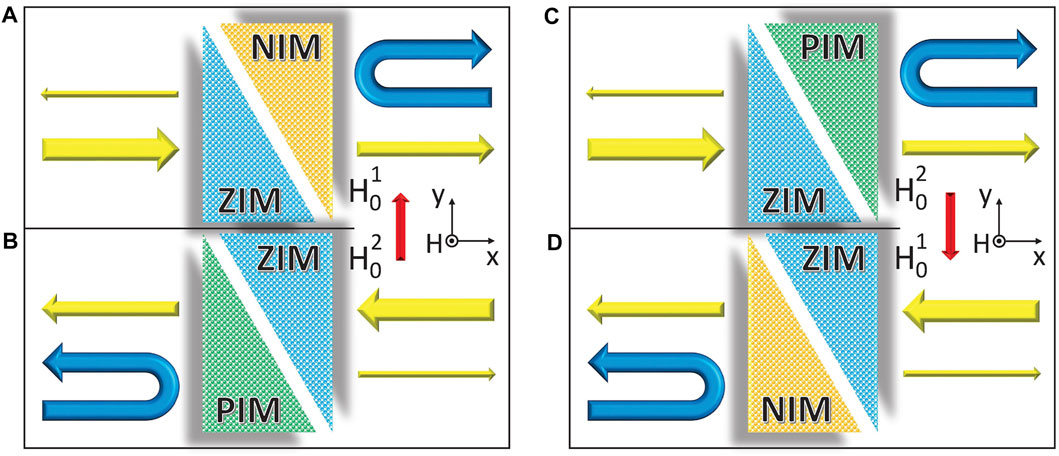
FIGURE 1. Schematic diagram illustrating the reconfigurable unidirectional propagation by HSMMs with ZIMs, NIMs, and PIMs as the building blocks. (A) For the HSMM made up of the ZIM and NIM, the LHS incidence corresponds to the “passing” state as marked by the yellow arrows, while the RHS incidence corresponds to the total reflection as marked by the blue arrows. (B) By decreasing the BMF from
To examine the zero-index features of the MMs, we first retrieve the effective constitutive parameters by using the coherent potential approximation–based effective-medium theory (Jin et al., 2009). For the convenience of analysis, two typical MMs with the same lattice separation a = 15 mm and yet different ferrite rod radii are considered to obtain the required effective indices so that they can be used as the appropriate building blocks. Two typical rod radii of r1 = 3.64 mm and r2 = 3.82 mm are chosen, and the corresponding effective constitutive parameters are calculated and presented in Figures 2B,D, respectively. At the operating frequency f = 2.5 GHz, it can be found that the effective permittivity is ɛeff = − 0.5 and the effective permeability is μeff = − 2.0 for r1 = 3.64 mm, corresponding to the ENI of
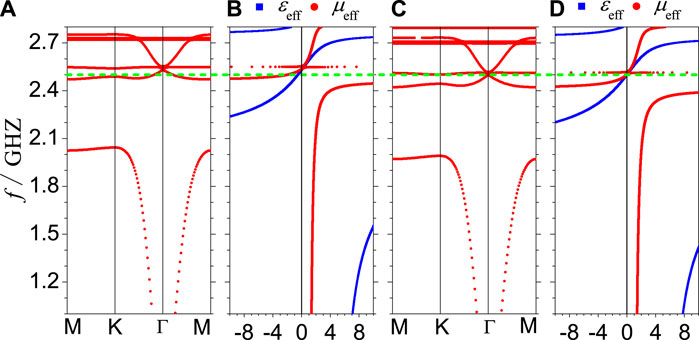
FIGURE 2. Photonic band diagrams (A,C) as well as the corresponding effective permittivities ɛeff and permeabilities μeff (B,D) for the triangular lattice of MMs with the same lattice separation a = 15 mm but different ferrite rod radii r = 3.64 mm (A,B) and 3.82 mm (C,D), respectively. The BMF is the same for two MMs with the magnitude H0 = 500 Oe. The green dashed line marks the operating frequency f = 2.5 GHz, which is fixed unchanged for all the HSMMs.
Then, we turn to examine the dependence of the effective constitutive parameters on the filling ratio by plotting ɛeff and μeff as the functions of the rod radius at the operating frequency f = 2.5 GHz for the fixed lattice separation a = 15 mm. The result is shown in Figure 3A, where both ɛeff and μeff are nearly continuously tuned in a specified range of the rod radius. For the convenience of comparison, two typical rod radii r1 = 3.64 mm and r2 = 3.82 mm discussed in Figure 2 are denoted by green solid lines, and by further increasing the rod radius to r3 = 4.2 mm, the effective index is turned from the ENI of neff, 1 to the EZI of neff, 2, and then to the EPI of neff, 3 = 1 with ɛeff, 3 = 1.25 and μeff, 3 = 0.8. With the above three MMs as the building blocks, two kinds of HSMMs are to be constructed with the combinations of either EZI and ENI or EZI and EPI. To realize the reconfigurable unidirectionality, a flexibly tunable effective index is required. Therefore, the effective parameters ɛeff and μeff are also plotted as the functions of a BMF H0. Two delicately designed MMs with the lattice separation
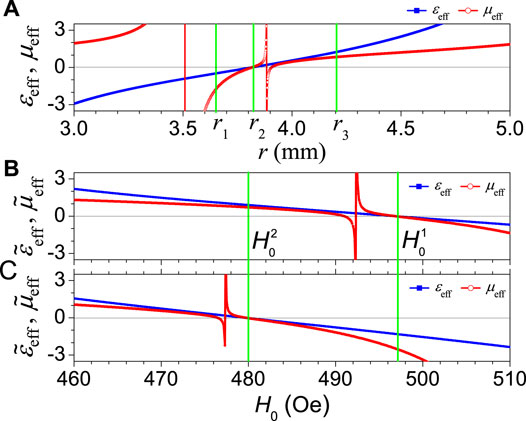
FIGURE 3. (A) The effective constitutive parameters ɛeff and μeff are plotted as the functions of the rod radius r for the MM with the lattice separation fixed as a = 15 mm. For another two MMs with the lattice separation
To visualize the unidirectional propagation, the electric field patterns are simulated by the use of multiple scattering theory (Felbacq et al., 1994; Liu and Lin, 2006), which can guarantee the high precision as well as the high efficiency. The results are shown in Figure 4, where a TM polarized Gaussian beam incident from both the LHS and the RHS on the HSMMs is presented. For the HSMM made up of the EZI and ENI, the Gaussian beam incident from the LHS experiences nearly no phase change in the EZI as evidenced by the nearly uniform electric field. Then, the beam is bent upward and enters the ENI. Finally, at the right interface of HSMM, the Gaussian beam is negatively refracted with the refractive angle of 30° as shown in panel A, corresponding to the “passing” state with the transmittance of about 49%. The Gaussian beam incident from the RHS enters the ENI and strikes obliquely at the interface of EZI. Due to the momentum mismatch, the Gaussian beam is totally reflected as shown in Figure 4B, giving rise to the unidirectional propagation of the Gaussian beam. Then, for the HSMM made up of the EZI and EPI, the LHS incident Gaussian beam can be transmitted and bent upward with the transmittance of about 57.8% and the angle of 30° with respect to the x axis, as shown in Figure 4C. Although both panel A and panel C exhibit the “LHS passing” state, the Gaussian beam is bent downward and upward, respectively, corresponding to the different beam steering effect. Similarly, as shown in panel D, the total reflection is observed for the RHS incident Gaussian beam, thus leading to the unidirectional propagation. It should be noted that, in Figure 4D, the effective index of the right part of heterostructure is about 1, equal to the refractive index of the air, resulting in an evident reflection beam. Differently, in Figure 4B, the effective index of the right part of heterostructure is about −1 and the impedance is mismatched to the air as indicated in Figure 3C, resulting in the complicate reflection and refraction at the interfaces of heterostructure. Therefore, on the RHS of the heterostructure, the interference pattern is observed, corresponding no longer to the reflected beam as that in Figure 4D. As a further extension of the present research, the oblique incident Gaussian beam can also be considered. In the usual case, the beam will be totally reflected for both the LHS and RHS incidence due to the momentum mismatch at the interface. Nonetheless, from the Lorentz reciprocity, we can expect that, for the oblique incidence with the incident angle of 30°, the reconfigurable unidirectional propagation can possibly be implemented. However, the oblique incidence will result in the larger reflectance at the interface, thus reducing the efficiency.
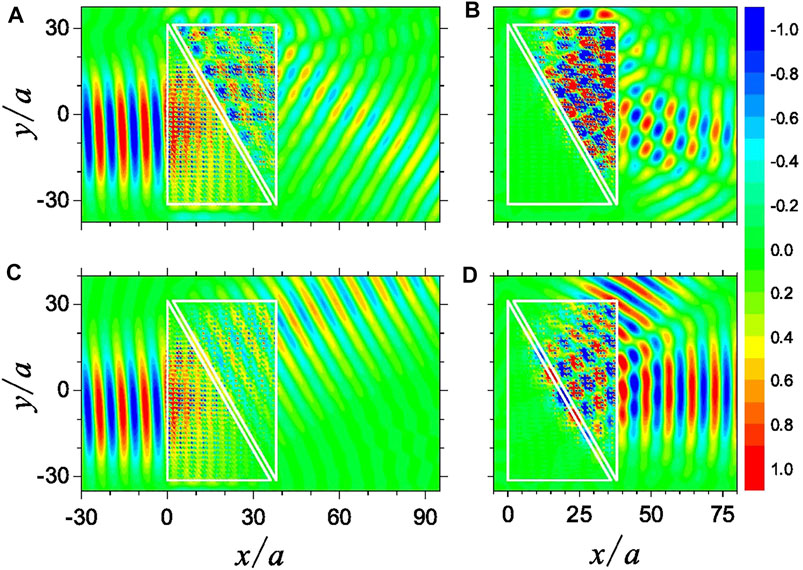
FIGURE 4. Electric field patterns illustrating the unidirectional propagation by the HSMM made up of the EZI and ENI with the LHS incident Gaussian beam exhibiting the “passing” state (A), but the RHS incident Gaussian beam exhibiting total reflection (B). For the HSMM made up of the EZI and EPI, the electric field patterns also exhibit the “passing” state for the LHS incidence (C) and the total reflection for the RHS incidence (D). The rod radii corresponding to the ENI of neff, 1 =−1, the EZI of neff, 2 = 0, and the EPI of neff, 3 = 1 are r1 = 3.64 mm, r2 = 3.82 mm, and r3 = 4.2 mm, respectively, as marked in Figure 3A. The BMF exerted upon two HSMMs is H0 = 500 Oe, and the operating frequency is f = 2.5 GHz, kept unchanged.
Although the unidirectional transmittance of the Gaussian beam is observed for the HSMMs presented in Figure 4, no further tunability on the unidirectionality can be realized. To improve the controllability, we turn to the MMs shown in Figures 3B,C, where the effective indices can be flexibly tuned by the BMF. Under the BMF
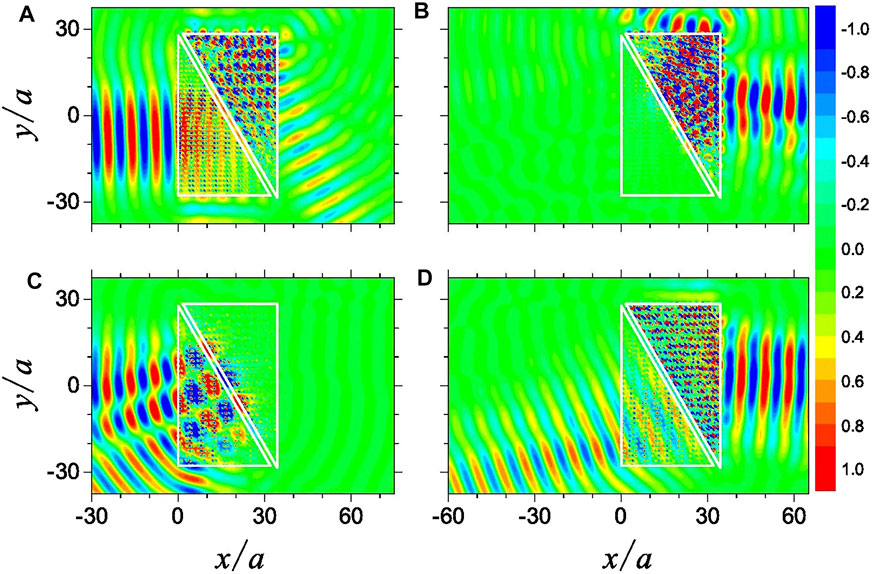
FIGURE 5. Electric field patterns illustrating the reconfigurable unidirectional propagation by the HSMM made up of the EZI and ENI with the LHS incidence exhibiting the “passing” state (A), but the RHS incidence exhibiting total reflection (B). By decreasing the bias magnetic field from
Actually, the construction of HSMM can be further tuned by interchanging the left part and the right part, which can lead to the reversing of the unidirectionality straightforwardly, namely, the transition between the “RHS passing” state and the “LHS passing” state. As an illustration of the idea, the interchanging of the left part and the right part in Figure 5C can lead to the construction of the second kind of HSMM with the combination of EZI and EPI. The electric field patterns are shown in Figures 6A,B, respectively, and compared to the results shown in Figures 5C,D, the unidirectionality is transformed from the “RHS passing” state to the “LHS passing” state. Compared to the field pattern in Figure 5A, the transmitted Gaussian beam is bent upward but not downward due to the change of effective index from negative to positive for the right part of HSMM. In addition, the total reflection for the RHS incidence in Figure 6B exhibits a deeper penetration into the left part compared to that in Figure 5B. The reason lies in that the absolute value of the refractive index of the left part in Figure 5B
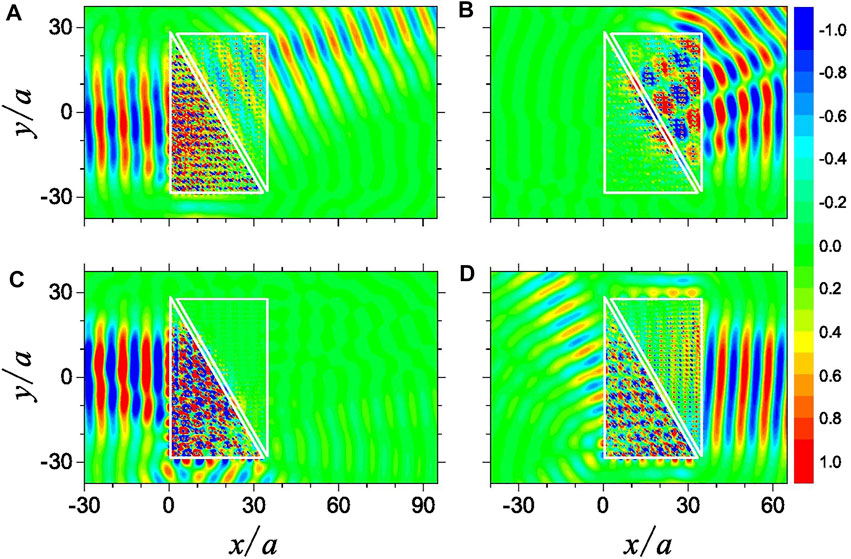
FIGURE 6. Electric field patterns illustrating the reconfigurable unidirectional propagation by the second kind of HSMM made up of the EZI and EPI with the LHS incidence exhibiting the “passing” state (A), but the RHS incidence exhibiting total reflection (B). By increasing the BMF from
Finally, it should be pointed out that, in our proof-of-principle demonstration, the absorption of ferrite material is not considered. For the HSMMs in our research, the thickness is three times as large as the operating wavelength, resulting in the reduction of nearly 50 percent for the transmitted beam considering exactly the material loss. Moreover, more than 2,000 ferrite rods were involved in the HSMMs, making our results hardly realizable in experiments. Actually, by designing the HSMMs with a little bit complicate configuration, the thickness can be miniaturized to the size of about 1 wavelength and the number of ferrite rods is decreased to be less than 1,000, resulting in a relatively weaker absorption, thus making our design more feasible and applicable. The BMF controlling the unidirectionality of HSMMs can be furnished by electromagnets (Wang et al., 2009; Poo et al., 2011). To increase the tunability of HSMMs, the coated ferrite rod with the dielectric core of high permittivity can be considered and the effective-medium theory can be extended to retrieve the corresponding effective constitutive parameters. In the present work, the essential part in designing the HSMM is obtaining the EZI tunable by a BMF. To generalize the concept to the optical range, the tunable EZI should be obtained first, and as such, the phase-change material can serve as a good candidate. Interestingly, by combining magnetic and non-magnetic metamaterials, the photonic heterostructures constructed by two different EZIs are expected to be designed, which can possibly be used to realize unidirectional beam steering.
In summary, the MMs composed of the ferrite rods are designed and demonstrated to possess the EZI, ENI, and EPI by tuning either the rod radius or the magnitude of BMF. Based on the effective-medium theory and photonic band diagrams, the EZI is corroborated and shown to be associated with the accidental degeneracy. Two kinds of HSMMs are constructed with the combination of either EZI and ENI or EZI and EPI, both of which exhibit unidirectional wave propagation. In addition, for the HSMMs made up of building blocks with the effective index tunable by the BMF, the reconfigurable unidirectional propagation is achieved with the unidirectionality reversible by either decreasing or increasing the BMF depending on the construction of the first or second kind of HSMM. The results presented in this work add more degrees of freedom in wave manipulation and can be possibly extended to the optical frequency range by introducing phase-change materials.
The original contributions presented in the study are included in the article/Supplementary Materials, further inquiries can be directed to the corresponding author.
All authors listed have made a substantial, direct, and intellectual contribution to the work and approved it for publication.
This work was supported by the National Natural Science Foundation of China (NNSFC) (grant No. 11574275) and Zhejiang Provincial Natural Science Foundation of China (LR16A040001). ZL was supported by the NNSFC (12074084), and QL was supported by the Basic Research Program of Science for Young Scholars in Universities of Guangxi Province.
The authors declare that the research was conducted in the absence of any commercial or financial relationships that could be construed as a potential conflict of interest.
All claims expressed in this article are solely those of the authors and do not necessarily represent those of their affiliated organizations, or those of the publisher, the editors, and the reviewers. Any product that may be evaluated in this article, or claim that may be made by its manufacturer, is not guaranteed or endorsed by the publisher.
Alù, A., Silveirinha, M. G., Salandrino, A., and Engheta, N. (2007). Epsilon-Near-Zero Metamaterials and Electromagnetic Sources: Tailoring the Radiation Phase Pattern. Phys. Rev. B 75 (15), 155410. doi:10.1103/PhysRevB.75.155410
Barik, S., Karasahin, A., Mittal, S., Waks, E., and Hafezi, M. (2020). Chiral Quantum Optics Using a Topological Resonator. Phys. Rev. B 101 (20), 205303. doi:10.1103/PhysRevB.101.205303
Brandenbourger, M., Locsin, X., Lerner, E., and Coulais, C. (2019). Non-Reciprocal Robotic Metamaterials. Nat. Commun. 10, 4608. doi:10.1038/s41467-019-12599-3
Chen, H., Lu, W., Li, J., Yu, J., Lin, Z., Ting Chan, C., et al. (2017). Manipulating Unidirectional Edge States via Magnetic Plasmonic Gradient Metasurfaces. Plasmonics 12 (4), 1079–1090. doi:10.1007/s11468-016-0361-8
Chen, J.-H., Qian, J., Guan, Y.-J., Ge, Y., Yuan, S.-Q., Sun, H.-X., et al. (2021). Broadband Bidirectional and Multi-Channel Unidirectional Acoustic Insulation by Mode-Conversion Phased Units. Front. Mater. 8, 766491. doi:10.3389/fmats.2021.766491
Chen, J., Liang, W., and Li, Z.-Y. (2020). Antichiral One-Way Edge States in a Gyromagnetic Photonic Crystal. Phys. Rev. B 101 (21), 214102. doi:10.1103/PhysRevB.101.214102
Chen, Y., He, X.-T., Cheng, Y.-J., Qiu, H.-Y., Feng, L.-T., Zhang, M., et al. (2021). Topologically Protected Valley-Dependent Quantum Photonic Circuits. Phys. Rev. Lett. 126 (23), 230503. doi:10.1103/PhysRevLett.126.230503
Chu, H., Li, Q., Liu, B., Luo, J., Sun, S., Hang, Z. H., et al. (2018). A Hybrid Invisibility Cloak Based on Integration of Transparent Metasurfaces and Zero-Index Materials. Light Sci. Appl. 7, 50. doi:10.1038/s41377-018-0052-7
Chui, S. T., Liu, S., and Lin, Z. (2010). Reflected Wave of Finite Circulation from Magnetic Photonic Crystals. J. Phys. Condens. Matter 22 (18), 182201. doi:10.1088/0953-8984/22/18/182201
Cicek, A., Adem Kaya, O., and Ulug, B. (2012). Refraction-Type Sonic Crystal Junction Diode. Appl. Phys. Lett. 100 (11), 111905. doi:10.1063/1.3694020
Coulais, C., Sounas, D., and Alù, A. (2017). Static Non-reciprocity in Mechanical Metamaterials. Nature 542 (7642), 461–464. doi:10.1038/nature21044
Dass, C. K., Kwon, H., Vangala, S., Smith, E. M., Cleary, J. W., Guo, J., et al. (2020). Gap-Plasmon-Enhanced Second-Harmonic Generation in Epsilon-Near-Zero Nanolayers. ACS Photon. 7 (1), 174–179. doi:10.1021/acsphotonics.9b01350
Deng, C.-Z., Ho, Y.-L., Clark, J. K., Yatsui, T., and Delaunay, J.-J. (2020). Light Switching with a Metal-free Chiral-Sensitive Metasurface at Telecommunication Wavelengths. ACS Photon. 7 (10), 2915–2922. doi:10.1021/acsphotonics.0c01377
Dubois, M., Shi, C., Zhu, X., Wang, Y., and Zhang, X. (2017). Observation of Acoustic Dirac-like Cone and Double Zero Refractive Index. Nat. Commun. 8, 14871. doi:10.1038/ncomms14871
Fang, K., and Fan, S. (2013). Controlling the Flow of Light Using the Inhomogeneous Effective Gauge Field that Emerges from Dynamic Modulation. Phys. Rev. Lett. 111 (20), 203901. doi:10.1103/PhysRevLett.111.203901
Felbacq, D., Tayeb, G., and Maystre, D. (1994). Scattering by a Random Set of Parallel Cylinders. J. Opt. Soc. Am. A. 11 (9), 2526. doi:10.1364/JOSAA.11.002526
Frese, D., Wei, Q., Wang, Y., Huang, L., and Zentgraf, T. (2019). Nonreciprocal Asymmetric Polarization Encryption by Layered Plasmonic Metasurfaces. Nano Lett. 19 (6), 3976–3980. doi:10.1021/acs.nanolett.9b01298
Fu, Y., Xu, L., Hong Hang, Z., and Chen, H. (2014). Unidirectional Transmission Using Array of Zero-Refractive-Index Metamaterials. Appl. Phys. Lett. 104 (19), 193509. doi:10.1063/1.4878400
Gu, Z., Fang, X., Liu, T., Gao, H., Liang, S., Li, Y., et al. (2021). Tunable Asymmetric Acoustic Transmission via Binary Metasurface and Zero-Index Metamaterials. Appl. Phys. Lett. 118 (11), 113501. doi:10.1063/5.0046756
Guo, X., Ding, Y., Duan, Y., and Ni, X. (2019). Nonreciprocal Metasurface with Space-Time Phase Modulation. Light Sci. Appl. 8 (1), 123. doi:10.1038/s41377-019-0225-z
Hajian, H., Ozbay, E., and Caglayan, H. (2016). Enhanced Transmission and Beaming via a Zero-Index Photonic Crystal. Appl. Phys. Lett. 109 (3), 031105. doi:10.1063/1.4959085
Han, Y., Yu, X., Hou, M., Zhou, J., Chen, H., and Liu, S. (2016). Asymmetric Light Propagation Based on Complex All-Dielectric Graded Photonic Crystals. J. Opt. 18 (7), 075105. doi:10.1088/2040-8978/18/7/075105
He, X.-T., Liang, E.-T., Yuan, J.-J., Qiu, H.-Y., Chen, X.-D., Zhao, F.-L., et al. (2019). A Silicon-On-Insulator Slab for Topological Valley Transport. Nat. Commun. 10, 872. doi:10.1038/s41467-019-08881-z
Huang, X., Lai, Y., Hang, Z. H., Zheng, H., and Chan, C. T. (2011). Dirac Cones Induced by Accidental Degeneracy in Photonic Crystals and Zero-Refractive-Index Materials. Nat. Mater 10 (8), 582–586. doi:10.1038/NMAT3030
Jin, J., Liu, S., Lin, Z., and Chui, S. T. (2009). Effective-Medium Theory for Anisotropic Magnetic Metamaterials. Phys. Rev. B 80 (11), 115101. doi:10.1103/PhysRevB.80.115101
Joannopoulos, J. D., Meade, R. D., and Winn, J. N. (1995). Photonic Crystals. Princeton: Princeton University Press.
Kan, W., Guo, M., and Shen, Z. (2018). Broadband Unidirectional Invisibility for Airborne Sound. Appl. Phys. Lett. 112 (20), 203502. doi:10.1063/1.5019771
Khanikaev, A. B., Hossein Mousavi, S., Tse, W.-K., Kargarian, M., MacDonald, A. H., and Shvets, G. (2013). Photonic Topological Insulators. Nat. Mater 12 (3), 233–239. doi:10.1038/NMAT3520
Li, B., Wang, L., and Casati, G. (2004). Thermal Diode: Rectification of Heat Flux. Phys. Rev. Lett. 93 (18), 184301. doi:10.1103/PhysRevLett.93.184301
Li, J., Li, J., Zheng, C., Yue, Z., Wang, S., Li, M., et al. (2021). Active Controllable Spin-Selective Terahertz Asymmetric Transmission Based on All-Silicon Metasurfaces. Appl. Phys. Lett. 118 (22), 221110. doi:10.1063/5.0053236
Li, X.-F., Ni, X., Feng, L., Lu, M.-H., He, C., and Chen, Y.-F. (2011). Tunable Unidirectional Sound Propagation through a Sonic-Crystal-Based Acoustic Diode. Phys. Rev. Lett. 106 (8), 084301. doi:10.1103/PhysRevLett.106.084301
Li, Y., Liang, B., Gu, Z.-M., Zou, X.-Y., and Cheng, J.-C. (2013). Unidirectional Acoustic Transmission through a Prism with Near-Zero Refractive Index. Appl. Phys. Lett. 103 (5), 053505. doi:10.1063/1.4817249
Li, Y., Zhu, K.-J., Peng, Y.-G., Li, W., Yang, T., Xu, H.-X., et al. (2019). Thermal Meta-Device in Analogue of Zero-Index Photonics. Nat. Mater 18 (1), 48–54. doi:10.1038/s41563-018-0239-6
Liang, B., Guo, X. S., Tu, J., Zhang, D., and Cheng, J. C. (2010). An Acoustic Rectifier. Nat. Mater 9 (12), 989–992. doi:10.1038/NMAT2881
Liberal, I., and Engheta, N. (2017). Near-Zero Refractive Index Photonics. Nat. Photon 11 (3), 149–158. doi:10.1038/NPHOTON.2017.13
Liberal, I., Lobet, M., Li, Y., and Engheta, N. (2020). Near-Zero-Index Media as Electromagnetic Ideal Fluids. Proc. Natl. Acad. Sci. USA 117 (39), 24050–24054. doi:10.1073/pnas.2008143117
Lin, J., Mueller, J. P. B., Wang, Q., Yuan, G., Antoniou, N., Yuan, X.-C., et al. (2013). Polarization-Controlled Tunable Directional Coupling of Surface Plasmon Polaritons. Science 340 (6130), 331–334. doi:10.1126/science.1233746
Lin, Z., Ramezani, H., Eichelkraut, T., Kottos, T., Cao, H., and Christodoulides, D. N. (2011). Unidirectional Invisibility Induced byPT-Symmetric Periodic Structures. Phys. Rev. Lett. 106 (21), 213901. doi:10.1103/PhysRevLett.106.213901
Liu, F., and Liu, Z. (2015). Elastic Waves Scattering without Conversion in Metamaterials with Simultaneous Zero Indices for Longitudinal and Transverse Waves. Phys. Rev. Lett. 115 (17), 175502. doi:10.1103/PhysRevLett.115.175502
Liu, M.-H., Liu, G.-S., Zou, X.-Y., and Cheng, J.-C. (2021). Acoustic Constant Mode One-Way Device Based on Wave Pattern Filter. Appl. Phys. Lett. 118 (26), 263503. doi:10.1063/5.0052988
Liu, S., Chen, W., Du, J., Lin, Z., Chui, S. T., and Chan, C. T. (2008a). Manipulating Negative-Refractive Behavior with a Magnetic Field. Phys. Rev. Lett. 101 (15), 157407. doi:10.1103/PhysRevLett.101.157407
Liu, S., Du, J., Lin, Z., Wu, R. X., and Chui, S. T. (2008b). Formation of Robust and Completely Tunable Resonant Photonic Band Gaps. Phys. Rev. B 78 (15), 155101. doi:10.1103/PhysRevB.78.155101
Liu, S., and Lin, Z. (2006). Opening up Complete Photonic Bandgaps in Three-Dimensional Photonic Crystals Consisting of Biaxial Dielectric Spheres. Phys. Rev. E 73 (6), 066609. doi:10.1103/PhysRevE.73.066609
Liu, S., Lu, W., Lin, Z., and Chui, S. T. (2010). Magnetically Controllable Unidirectional Electromagnetic Waveguiding Devices Designed with Metamaterials. Appl. Phys. Lett. 97 (20), 201113. doi:10.1063/1.3520141
Liu, S., Lu, W., Lin, Z., and Chui, S. T. (2011). Molding Reflection from Metamaterials Based on Magnetic Surface Plasmons. Phys. Rev. B 84 (4), 045425. doi:10.1103/PhysRevB.84.045425
Lu, J., Qiu, C., Ke, M., and Liu, Z. (2016). Valley Vortex States in Sonic Crystals. Phys. Rev. Lett. 116 (9), , 093901. doi:10.1103/PhysRevLett.116.093901
Midya, B. (2014). Supersymmetry-generated One-Way-invisiblePT-Symmetric Optical Crystals. Phys. Rev. A. 89 (3), 032116. doi:10.1103/PhysRevA.89.032116
Morgado, T. A., and Silveirinha, M. G. (2018). Drift-Induced Unidirectional Graphene Plasmons. ACS Photon. 5 (11), 4253–4258. doi:10.1021/acsphotonics.8b00987
Mousavi, S. H., Khanikaev, A. B., and Wang, Z. (2015). Topologically Protected Elastic Waves in Phononic Metamaterials. Nat. Commun. 6, 8682. doi:10.1038/ncomms9682
Nguyen, V. C., Chen, L., and Halterman, K. (2010). Total Transmission and Total Reflection by Zero Index Metamaterials with Defects. Phys. Rev. Lett. 105 (23), 233908. doi:10.1103/PhysRevLett.105.233908
Özgün, E., Ozbay, E., and Caglayan, H. (2016). Tunable Zero-Index Photonic Crystal Waveguide for Two-Qubit Entanglement Detection. ACS Photon. 3 (11), 2129–2133. doi:10.1021/acsphotonics.6b00576
Pfeiffer, C., Zhang, C., Ray, V., Guo, L. J., and Grbic, A. (2014). High Performance Bianisotropic Metasurfaces: Asymmetric Transmission of Light. Phys. Rev. Lett. 113 (2), 023902. doi:10.1103/PhysRevLett.113.023902
Poo, Y., Wu, R.-X., Lin, Z., Yang, Y., and Chan, C. T. (2011). Experimental Realization of Self-Guiding Unidirectional Electromagnetic Edge States. Phys. Rev. Lett. 106 (9), 093903. doi:10.1103/PhysRevLett.106.093903
Pors, A., Nielsen, M. G., Bernardin, T., Weeber, J.-C., and Bozhevolnyi, S. I. (2014). Efficient Unidirectional Polarization-Controlled Excitation of Surface Plasmon Polaritons. Light Sci. Appl. 3, e197. doi:10.1038/lsa.2014.78
Qian, J., Wang, Y., Xia, J.-P., Ge, Y., Yuan, S.-Q., Sun, H.-X., et al. (2020). Broadband Integrative Acoustic Asymmetric Focusing Lens Based on Mode-Conversion Meta-Atoms. Appl. Phys. Lett. 116 (22), 223505. doi:10.1063/5.0004579
Shen, C., Xie, Y., Li, J., Cummer, S. A., and Jing, Y. (2016). Asymmetric Acoustic Transmission through Near-Zero-Index and Gradient-Index Metasurfaces. Appl. Phys. Lett. 108 (22), 223502. doi:10.1063/1.4953264
Shi, Y., Yu, Z., and Fan, S. (2015). Limitations of Nonlinear Optical Isolators Due to Dynamic Reciprocity. Nat. Photon 9 (6), 388–392. doi:10.1038/NPHOTON.2015.79
Silveirinha, M., and Engheta, N. (2006). Tunneling of Electromagnetic Energy through Subwavelength Channels and Bends Usingε-Near-Zero Materials. Phys. Rev. Lett. 97 (15), 157403. doi:10.1103/PhysRevLett.97.157403
Sounas, D. L., Caloz, C., and Alù, A. (2013). Giant Non-reciprocity at the Subwavelength Scale Using Angular Momentum-Biased Metamaterials. Nat. Commun. 4, 2407. doi:10.1038/ncomms3407
Suchowski, H., O’Brien, K., Wong, Z. J., Salandrino, A., Yin, X., and Zhang, X. (2013). Phase Mismatch-free Nonlinear Propagation in Optical Zero-Index Materials. Science 342 (6163), 1223–1226. doi:10.1126/science.1244303
Thomaschewski, M., Yang, Y., Wolff, C., Roberts, A. S., and Bozhevolnyi, S. I. (2019). On-Chip Detection of Optical Spin-Orbit Interactions in Plasmonic Nanocircuits. Nano Lett. 19 (2), 1166–1171. doi:10.1021/acs.nanolett.8b04611
Wang, M., Zhang, R.-Y., Zhang, L., Wang, D., Guo, Q., Zhang, Z.-Q., et al. (2021). Topological One-Way Large-Area Waveguide States in Magnetic Photonic Crystals. Phys. Rev. Lett. 126 (6), 067401. doi:10.1103/PhysRevLett.126.067401
Wang, S., Deng, Z.-L., Wang, Y., Zhou, Q., Wang, X., Cao, Y., et al. (2021). Arbitrary Polarization Conversion Dichroism Metasurfaces for All-In-One Full Poincaré Sphere Polarizers. Light Sci. Appl. 10 (1), 24. doi:10.1038/s41377-021-00468-y
Wang, Z., Chong, Y. D., Joannopoulos, J. D., and Soljačić, M. (2008). Reflection-Free One-Way Edge Modes in a Gyromagnetic Photonic Crystal. Phys. Rev. Lett. 100 (1), 013905. doi:10.1103/PhysRevLett.100.013905
Wang, Z., Chong, Y., Joannopoulos, J. D., and Soljačić, M. (2009). Observation of Unidirectional Backscattering-Immune Topological Electromagnetic States. Nature 461 (7265), 772–775. doi:10.1038/nature08293
Wu, H., Luo, Q., Chen, H., Han, Y., Yu, X., and Liu, S. (2019). Magnetically Controllable Nonreciprocal Goos-Hänchen Shift Supported by a Magnetic Plasmonic Gradient Metasurface. Phys. Rev. A. 99 (3), 033820. doi:10.1103/PhysRevA.99.033820
Xu, C., Chu, H., Luo, J., Hang, Z. H., Wu, Y., and Lai, Y. (2021). Three-Dimensional Electromagnetic Void Space. Phys. Rev. Lett. 127 (12), 123902. doi:10.1103/PhysRevLett.127.123902
Xu, J., Song, G., Zhang, Z., Yang, Y., Chen, H., Zubairy, M. S., et al. (2016). Unidirectional Single-Photon Generation via Matched Zero-Index Metamaterials. Phys. Rev. B 94 (22), 220103. doi:10.1103/PhysRevB.94.220103
Yan, M., Lu, J., Li, F., Deng, W., Huang, X., Ma, J., et al. (2018). On-Chip Valley Topological Materials for Elastic Wave Manipulation. Nat. Mater 17 (11), 993–998. doi:10.1038/s41563-018-0191-5
Yu, J., Chen, H., Wu, Y., and Liu, S. (2012). Magnetically Manipulable Perfect Unidirectional Absorber Based on Nonreciprocal Magnetic Surface Plasmon. EPL 100 (4), 47007. doi:10.1209/0295-5075/100/47007
Yu, X., Chen, H., Lin, H., Zhou, J., Yu, J., Qian, C., et al. (2014). Continuously Tuning Effective Refractive Index Based on Thermally Controllable Magnetic Metamaterials. Opt. Lett. 39 (16), 4643. doi:10.1364/OL.39.004643
Yu, Z., and Fan, S. (2009). Complete Optical Isolation Created by Indirect Interband Photonic Transitions. Nat. Photon 3 (2), 91–94. doi:10.1038/NPHOTON.2008.273
Yuan, L., and Lu, Y. Y. (2019). Unidirectional Reflectionless Transmission for Two-Dimensional PT -symmetric Periodic Structures. Phys. Rev. A. 100 (5), 053805. doi:10.1103/PhysRevA.100.053805
Zangeneh-Nejad, F., and Fleury, R. (2020). Zero-Index Weyl Metamaterials. Phys. Rev. Lett. 125 (5), 054301. doi:10.1103/PhysRevLett.125.054301
Zhang, X., Liu, L., Lu, M.-H., and Chen, Y.-F. (2021). Valley-selective Topological Corner States in Sonic Crystals. Phys. Rev. Lett. 126 (15), 156401. doi:10.1103/PhysRevLett.126.156401
Zhang, Y., Zhou, C.-L., Yi, H.-L., and Tan, H.-P. (2020). Radiative Thermal Diode Mediated by Nonreciprocal Graphene Plasmon Waveguides. Phys. Rev. Appl. 13 (3), 034021. doi:10.1103/PhysRevApplied.13.034021
Keywords: reconfigurable unidirectional propagation, zero-index material, negative-index material, magnetic metamaterial, heterostructured metamaterials
Citation: Luo Q, Zhao L, Zhou J, Zhang L, Wen G, Ba Q, Wu H, Lin Z and Liu S (2022) Magnetically Reconfigurable Unidirectional Propagation of Electromagnetic Waves by Zero-Index–Based Heterostructured Metamaterials. Front. Mater. 9:845344. doi: 10.3389/fmats.2022.845344
Received: 29 December 2021; Accepted: 03 February 2022;
Published: 16 March 2022.
Edited by:
Xiao-Dong Chen, Sun Yat-sen University, ChinaReviewed by:
Hodjat Hajian, Bilkent University, TurkeyCopyright © 2022 Luo, Zhao, Zhou, Zhang, Wen, Ba, Wu, Lin and Liu. This is an open-access article distributed under the terms of the Creative Commons Attribution License (CC BY). The use, distribution or reproduction in other forums is permitted, provided the original author(s) and the copyright owner(s) are credited and that the original publication in this journal is cited, in accordance with accepted academic practice. No use, distribution or reproduction is permitted which does not comply with these terms.
*Correspondence: Shiyang Liu, c3lsaXVAempudS5jbg==
Disclaimer: All claims expressed in this article are solely those of the authors and do not necessarily represent those of their affiliated organizations, or those of the publisher, the editors and the reviewers. Any product that may be evaluated in this article or claim that may be made by its manufacturer is not guaranteed or endorsed by the publisher.
Research integrity at Frontiers

Learn more about the work of our research integrity team to safeguard the quality of each article we publish.